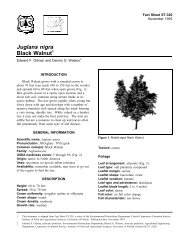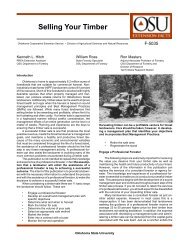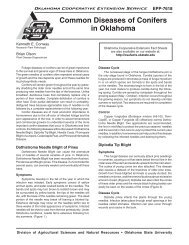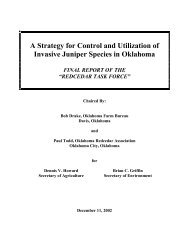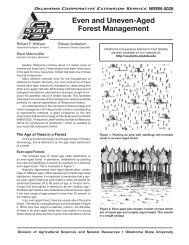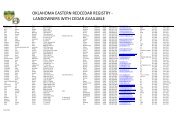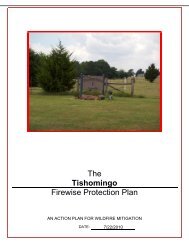Introduction to Oklahoma's Forest Regeneration Center
Introduction to Oklahoma's Forest Regeneration Center
Introduction to Oklahoma's Forest Regeneration Center
You also want an ePaper? Increase the reach of your titles
YUMPU automatically turns print PDFs into web optimized ePapers that Google loves.
Growing Oklahoma’sfuture forestsWhile driving through Oklahoma you may have seenwindbreaks, extensive timber plantations and wildlife habitatimproved through tree plantings. Have you ever wondered wheremany of these trees and shrubs come from?The Oklahoma <strong>Forest</strong> <strong>Regeneration</strong> <strong>Center</strong>, establishedin 1926, provides quality forest conservation seedlings <strong>to</strong>landowners throughout the state. The <strong>Regeneration</strong> <strong>Center</strong> islocated in Goldsby, Oklahoma, south of Norman.Approximately 50 species of tree and shrub seedlingsare grown and distributed <strong>to</strong> rural landowners and naturalresource organizations every year.Because tree planting isoften challenging in Oklahoma’sdiverse and frequently harshclimate, most of our seedlings aregrown from improved or superiornative seed sources. <strong>Forest</strong>ers havediscovered that local seed sourcesusually have increased survival andperform better when replanted. Asa result, soil stabilizes sooner, waterquality improves faster, and avariety of wildlife species areprovided with added food andcover.Our conservation seedlings provide numerous benefitswhich are described in detail in the next section. For costs andordering information, please refer <strong>to</strong> the back.Developing timber resourcesWe are continually evaluating and improving seedsources <strong>to</strong> ensure landowners receive trees which are highlyadapted and marketable.For example, our work with Virginia pine has helpedChristmas tree growers <strong>to</strong> produce faster growing, lowermaintenance trees. This means growers have a viable crop soonerwith higher harvest yields.On Grant Mabry’s ranch near Wilbur<strong>to</strong>n, the use ofimproved loblolly pine seedlings allowed this forest <strong>to</strong> produce20% more wood. Mabry says he has been extremely pleased withthe rapid growth of his trees. He has found a viable economic usefor land <strong>to</strong>o poor for cattle grazing, but well-suited for timber,wildlife habitat and watershed protection.WindbreaksIn addition <strong>to</strong> dressing up your rural home, windbreaksof trees and shrubs can add a new dimension of comfort. Whileevergreens color drab winter surroundings, deciduous trees andflowering shrubs add splashes of color in spring and summer.Best of all, windbreaks protect the house and yard from stingingwinds, blowing soil and drifting snow.Field windbreaks are designed <strong>to</strong> protect the soil fromwind erosion, guard crops, and reduce feed costs of lives<strong>to</strong>ck. Inaddition, windbreaks can improve wildlife habitat by connectingexisting or planned perennial vegetation, such as woodlots,stream banks or other wetland areas.Ensuring waterqualityWhen you turn on the water tap,what you may not realize is thatthe water you are drinking inyour area of Oklahoma may bedirectly affected by forestlandshundreds of miles away. How?Trees and other vegetation act asnatural filters for air and water pollution. As rain falls, it carriessoil, chemicals and organic material along <strong>to</strong> our waterways.<strong>Forest</strong>ed watersheds and trees near streams, rivers and creeks areimportant for maintaining high quality drinking water.In addition <strong>to</strong> filtering out soil and pollutants, thesetrees provide habitat for the organisms living in the water. Treesalso offer shade <strong>to</strong> the stream, preventing high watertemperatures, which can harm fish and other aquatic life.Erosion controlThousands of gullies in Oklahoma are in various stagesof development, creating serious problems for landowners.Erosion has been controlled in many areas, thanks <strong>to</strong> <strong>Forest</strong>ry’sconservation seedlings.Trees are key <strong>to</strong> the res<strong>to</strong>ration of riparian zones. Forinstance, under the guidance of forest hydrologists Bob Millerand John Norris, foresters used a combination of practices: treeplanting, rock gabions, cattle panels and mulch <strong>to</strong> stabilize a verylarge gully system in southern Tillman County. This verysuccessful project reduced sediment flowing in<strong>to</strong> the Red River,slowed the loss of farmland and res<strong>to</strong>red a riparian area forwildlife and water quality protection.As Norris said, "We emphasized using low-costpractices, especially tree planting, that landowners can afford anddo themselves. In this case it really worked!"Similar results were seen along the Cimarron River. Ina forest stewardship program near Enid, Service <strong>Forest</strong>er DanStidham recommended <strong>to</strong> landowners along the river that theyplant black locust. Stidham says the trees grow quickly whichprovides rapid protection <strong>to</strong> eroded soils. Black locusts sproutfrom the stumps very well, so they can be cut back every fewyears. The result is a nice harvest of firewood. Trunks will beginsprouting soon afterward and the new trees will grow much fasterbecause of the extensive root system already in place.
Tree Bear says,"Good thingscome from trees!"For additional assistance, contact the<strong>Forest</strong>ry Services office in your area.Southeast AreaPO Box 40Broken Bow, OK 74728-0040580-584-3351 Fax: 580-584-3352FIRE: 1-800-299-2468Northeast Area22082 South J.F. Davis LaneTahlequah, OK 74464-9805918-456-6139 Fax: 918-456-4155FIRE: 1-800-299-FIREEast Central AreaPO Box 297Wilbur<strong>to</strong>n, OK 74578-0297918-465-2082 Fax: 918-465-2005FIRE: 1-800-375-2056Central and Western Area830 NE 12th AvenueGoldsby, OK 73093-9017405-288-23851-800-517-3673 (outside Oklahoma City metro area)FAX: 405-288-6326State Offices2800 N. LincolnOklahoma City, OK 73105405-522-6158Department of Agriculture, Food and <strong>Forest</strong>ryP.O. Box 528804Oklahoma City, OK 73152About ourseedlingsOur conservation seedlingsprovide numerous benefits including:• Producing forest products• Reducing soil erosion fromwind and water• Decreasing energy and utility costs• Preventing snow from blowing and drifting on thehighways• Providing wildlife food and cover• Protecting lives<strong>to</strong>ck• Providing crop and forage improvement• Ensuring water quality of our lakes and rivers• Res<strong>to</strong>ring riparian areas• Closing old landfills and waste treatment areas• Teaching the next generation about our environmentWe require a minimum order of 200 seedlings. Trees aregenerally available during the dormant season, January throughMarch. Offered on a first-come, first-serve basis, the seedlings arebare-root or containerized, one <strong>to</strong> two years old, and range from 6-16 inches tall. Seedlings are only available for rural conservationprojects and trees cannot be resold as live plants. Telephone andfax orders require a credit card.To order contact The <strong>Forest</strong> <strong>Regeneration</strong> <strong>Center</strong>830 NE 12th AvenueGoldsby, Oklahoma 73093-9017Phone: (405) 288-23851-800-517-3673 (outside Oklahoma City metro area)Fax: 405-288-6326www.oda.state.ok.us/regp.htmIn accordance with Federal law and U.S. Department of Agriculture policy, thisinstitution is prohibited from discriminating on the basis of race, color, nationalorigin, sex, age or disability. To file a complaint of discrimination write USDA,Direc<strong>to</strong>r, Office of Civil Rights, Room 326-W, Whitten Bldg., 1400 Independence Ave.SW, Washing<strong>to</strong>n D.C. 20250-9410 or call (202) 720-6964 (voice and TDD). USDA isan equal opportunity provider and employer. 10,000 copies of thisbrochure have been printed at a cost of $1,225.



